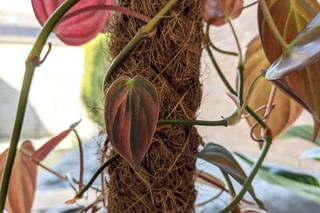How to use a Moss pole for your houseplants
Moss poles are a great way to teach your plants how and where to grow. In this plant care guide, we're going to look at how you can use a moss pole for your climbing plants. A moss pole might seem intimidating at first, but once you've used it for the first time, it's really nice and easy to use.

In this guide, we'll go over a few things related to moss poles:
Let's get right into it and let's see why you might want to use a moss pole for your houseplants.
Why should you use a moss pole for your houseplants?
You should use a moss pole if you want to help your plants grow in a certain way. In most cases, plant owners love using moss poles to teach their plants to grow upwards. If you grow your plants up, rather than down or out, you can do this for a variety of reasons:
- You have more flexibility on where you can put your plant
- Your plant takes in less space (space for more plants!)
- You can "shape" your plant
- You like the way it makes your plant look
When you use a moss pole, you can "shape" your plant a little bit better. For example: when you grow a Monstera, you can decide in which direction your houseplant grows. If you were to not use a moss pole, your plant will grow however it wants to. There is nothing wrong with that, but it can limit the places you have available for your houseplant.
If you like to have a little bit more control over your plant's shape, a moss pole is a great way to do this.
What is a moss pole made of?
Now that you've got a good idea of why you should use a moss pole, let's see what it's usually made of. Moss poles are usually made from a variety of natural materials, such as dried moss, coconut fiber, and bamboo.
The materials are wrapped around the pole in vertical strips and secured with string or wire. This provides natural support for your houseplant's tendrils as they grow up along the pole.
The type of material you choose will depend on your specific plant. Some plants may need more support than others, so make sure to pick the moss pole that best suits your houseplant's needs.
The pole in the middle is usually made of either wood or plastic. Wood seems like a durable and good option, but I recommend against using a moss pole with a wooden stick. This wood will start to rot quite quickly and this could harm your plant.
If you have no other choice, you could wrap the wooden part of your moss pole in a plastic bag before sticking it in the soil. This will protect the moss pole and your plant long-term.
Which plants benefit from a moss pole?
Before we get into how you should use a moss pole, it's a great idea to see if your plant would benefit from one. The best plants to use a moss pole with, are either hanging plants with vines or climbing plants. Letting plants grow naturally would sound like an obvious choice when it comes to plant care. However, your houseplant might need your help more than you think.
In nature, your hanging or climbing houseplant most likely grows in jungles or other tropical places. It grows against trees and other solid structures like rocks. Your houseplant relies on these solid structures to give it an easy and stable place to grow. When you give your plants this solid structure to grow against you're promoting growth. This stable place to grow feels natural to your houseplant and it'll feel comfortable.
So the best plants to use a moss pole with are climbing plants like Monstera, or hanging plants like Golden Pothos or Philodendron.
How do you use a moss pole?
Now we're getting to the good part: we're going to look at how you can help your plant grow with a moss pole. The way you help your plant depends a little bit on the plant itself. If you have a Philodendron, which has quite thin vines, you will need some way to carefully keep the vines on the moss pole. But if you have a Monstera, which has thick stems, all you'll need to do is make sure you keep those stems as close to the moss pole as you can.
The materials you'll need to grow your plant with a moss pole are as follows:
- a moss pole (surprise, surprise)
- Velcro strips or gardening tubes
- a climbing plant
With these items, you can get started with using a moss pole for your houseplant.
The goal of using a moss pole with your houseplant is to make sure your plant touches the moss pole. The velcro strips are a great way to "bind" your plant to the moss pole in any way that looks good to you.
If you're doing this with a plant with thin vines, like the Philodendron, make sure to be very careful when putting it against the moss pole. The vines are easily damaged, so don't tie them to the moss pole too tightly.
As your plant keeps growing, you'll have to continue to bind the plant to the moss pole. You're continuously guiding the plant along the moss pole, as much and as long as you see fit. Over time, your houseplant will start to learn to grow against the moss pole by itself, especially if it grows air roots.
The Philodendron and Pothos will start to grow "roots", which they use to attach themselves to things like the moss pole. These plants will be able to quickly learn where and how to grow and you won't have to guide it for very long.
The Monstera grows a little bit more slowly, so you will need to teach it to grow upwards for a bit longer. Once the Monstera starts to grow around the moss pole, you won't have much work from it anymore.
Conclusion
If you want to shape your plant for your living space and make it look like you want it to look, a moss pole is a great option. Moss poles are a great fit for all climbing plants and help you to teach your plants how and where to grow. Once you get a climbing plant, like a Monstera, Philodendron, or Pothos, all you need is a moss pole and some way to connect it to your plant.
A moss pole might seem intimidating at first, but once you've used it for the first time, it's really nice and easy to use. When you help your plant in the beginning your plant will learn how to do it by itself quickly.
Thank you for reading this post! I hope it helps you to keep your plants healthy and beautiful! If you're looking for more guides on specific plants, you can always request a plant guide to get a guide for the plant you have trouble with.
Test your plant care knowledge
Quiz completed!
Want to learn more? Sign up for my newsletter to receive free tips in your inbox!
Sign up now!










